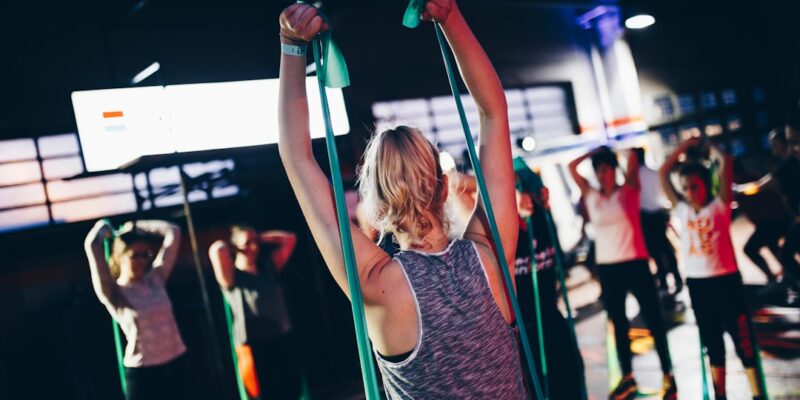
Rev Up Your Athletic Performance with CrossFit Training
CrossFit training has become increasingly popular among athletes of all levels. This high-intensity workout program combines elements of weightlifting, cardiovascular exercise, and bodyweight movements to improve overall fitness and athletic performance. CrossFit training focuses on functional movements that mimic real-life activities, making it a versatile and effective training method for athletes in various sports. In this article, we will explore the benefits of CrossFit training for athletes and how it can help improve endurance, strength, power, coordination, and mental well-being.
Key Takeaways
- CrossFit training is a high-intensity workout program that combines elements of weightlifting, gymnastics, and cardio.
- CrossFit training can improve athletic performance for athletes of all levels by increasing endurance, strength, power, and coordination.
- CrossFit training can help build endurance and stamina through workouts that focus on high-intensity intervals and functional movements.
- To maximize results in CrossFit training for strength and power, it’s important to focus on proper form and technique and gradually increase weight and intensity.
- Proper form and technique are crucial in CrossFit training to prevent injury and ensure optimal results.
What is CrossFit Training and How Can it Improve Your Athletic Performance?
CrossFit training is a fitness program that incorporates a wide range of exercises and movements to improve overall fitness and athletic performance. It combines elements of weightlifting, cardiovascular exercise, and bodyweight movements to create a high-intensity workout that targets multiple muscle groups and energy systems.
One of the main ways that CrossFit training can improve athletic performance is through its emphasis on functional movements. Functional movements are exercises that mimic real-life activities and require multiple muscle groups to work together. By training these movements, athletes can improve their overall strength, power, coordination, and balance.
Additionally, CrossFit training incorporates high-intensity interval training (HIIT), which has been shown to improve cardiovascular endurance and stamina. HIIT involves short bursts of intense exercise followed by periods of rest or lower-intensity exercise. This type of training can help athletes improve their aerobic capacity and anaerobic threshold, allowing them to perform at a higher level for longer periods of time.
The Benefits of CrossFit Training for Athletes of All Levels
CrossFit training can benefit athletes of all levels, from beginners to elite competitors. For beginners, CrossFit provides a structured and challenging workout program that can help them build a solid foundation of strength, endurance, and mobility. The program is scalable, meaning that exercises can be modified to suit individual fitness levels and abilities.
For intermediate athletes, CrossFit training can help them break through plateaus and reach new levels of performance. The varied and constantly changing workouts challenge the body in different ways, preventing adaptation and promoting continuous improvement. CrossFit also helps athletes develop mental toughness and resilience, which are essential for success in any sport.
Even elite athletes can benefit from incorporating CrossFit training into their routine. The program provides a well-rounded approach to fitness, targeting all aspects of physical performance. By incorporating CrossFit workouts into their training regimen, elite athletes can improve their overall strength, power, endurance, and flexibility, giving them a competitive edge.
How CrossFit Training Can Help You Build Endurance and Stamina
| Benefits of CrossFit Training for Endurance and Stamina |
|---|
| Improved cardiovascular health |
| Increased lung capacity |
| Enhanced muscular endurance |
| Greater aerobic and anaerobic capacity |
| Improved metabolic conditioning |
| Increased mental toughness and resilience |
| Greater ability to perform high-intensity workouts |
| Reduced risk of chronic diseases |
| Improved overall fitness and health |
Endurance and stamina are crucial for athletes in many sports, as they allow for sustained performance over long periods of time. CrossFit training can help improve endurance and stamina through its emphasis on high-intensity interval training (HIIT) and cardiovascular exercise.
HIIT workouts, which are a staple of CrossFit training, have been shown to improve cardiovascular endurance. The short bursts of intense exercise followed by periods of rest or lower-intensity exercise help to increase the heart’s efficiency and improve the body’s ability to use oxygen.
CrossFit workouts also incorporate cardiovascular exercises such as running, rowing, and cycling, which further improve endurance and stamina. These exercises target the aerobic energy system, which is responsible for providing energy during prolonged exercise. By regularly performing these exercises at high intensity, athletes can increase their aerobic capacity and improve their ability to perform at a high level for extended periods of time.
Some examples of CrossFit exercises that target endurance and stamina include running intervals, rowing sprints, and cycling workouts. These exercises can be performed at varying distances or durations to challenge the cardiovascular system and build endurance.
CrossFit Training for Strength and Power: How to Maximize Your Results
Strength and power are essential for athletes in many sports, as they allow for explosive movements and the ability to overcome resistance. CrossFit training can help improve strength and power through its emphasis on weightlifting and functional movements.
CrossFit workouts often include weightlifting exercises such as squats, deadlifts, cleans, and snatches. These exercises target major muscle groups and require the body to generate force against resistance. By regularly performing these exercises at high intensity, athletes can increase their overall strength and power.
In addition to weightlifting, CrossFit training incorporates functional movements that require multiple muscle groups to work together. These movements, such as burpees, box jumps, and kettlebell swings, help to improve overall strength and power by challenging the body in different ways.
To maximize results in CrossFit training for strength and power, athletes should focus on proper technique and form. This includes maintaining a neutral spine, engaging the core muscles, and using the appropriate amount of weight for each exercise. It is also important to gradually increase the intensity and volume of workouts over time to avoid overtraining and injury.
The Importance of Proper Form and Technique in CrossFit Training
Proper form and technique are crucial in CrossFit training to ensure safety and maximize results. Many CrossFit exercises involve complex movements that require coordination, balance, and stability. Performing these exercises with improper form can increase the risk of injury and limit the effectiveness of the workout.
One of the main reasons why proper form is important in CrossFit training is to prevent injury. Many CrossFit exercises involve heavy weights or high-impact movements, which can put stress on the joints and muscles if not performed correctly. By maintaining proper form, athletes can reduce the risk of strains, sprains, and other injuries.
Proper form also allows for optimal muscle activation and recruitment during exercises. By using the correct muscles and engaging them in the right way, athletes can maximize the effectiveness of each movement and achieve better results. This is especially important for compound exercises that target multiple muscle groups, such as squats and deadlifts.
To maintain proper form and technique in CrossFit exercises, athletes should focus on the following:
1. Start with a solid foundation: Before attempting more complex movements, athletes should master the basics and develop a strong foundation of strength, mobility, and stability.
2. Seek guidance from a qualified coach: Working with a knowledgeable coach can help athletes learn proper form and technique, as well as provide feedback and corrections during workouts.
3. Practice regularly: Consistency is key when it comes to maintaining proper form. Athletes should practice exercises regularly to reinforce good habits and improve technique over time.
4. Listen to your body: It is important to listen to your body and pay attention to any pain or discomfort during workouts. If something doesn’t feel right, it is better to stop and seek guidance rather than push through and risk injury.
How to Incorporate CrossFit Training into Your Athletic Routine
Incorporating CrossFit training into an existing athletic routine can be a great way to enhance overall fitness and performance. However, it is important to do so in a way that complements your specific sport and training goals.
One way to incorporate CrossFit training into your routine is to use it as a supplemental workout on days when you are not practicing or competing in your sport. This allows you to target different muscle groups and energy systems while giving your body time to recover from sport-specific training.
Another option is to integrate CrossFit exercises into your warm-up or cool-down routine. This can help activate different muscle groups, improve mobility, and prepare the body for the demands of your sport. For example, you could incorporate bodyweight exercises such as lunges, push-ups, or planks into your warm-up routine.
Some athletes choose to dedicate specific blocks of time to CrossFit training, either during the off-season or as part of a periodized training plan. This allows them to focus on building overall fitness and addressing any weaknesses or imbalances before returning to sport-specific training.
It is important to listen to your body and adjust your training volume and intensity as needed. CrossFit training can be intense and physically demanding, so it is important to give your body time to recover and adapt. This may involve reducing the frequency or duration of CrossFit workouts during periods of heavy sport-specific training.
CrossFit Training for Injury Prevention and Rehabilitation
CrossFit training can be a valuable tool for injury prevention and rehabilitation. The program focuses on functional movements that improve strength, stability, and mobility, which are all important for preventing injuries.
By incorporating exercises that target weak or imbalanced muscle groups, athletes can correct muscle imbalances and reduce the risk of overuse injuries. For example, if an athlete has weak glutes or hamstrings, they can incorporate exercises such as hip thrusts or Romanian deadlifts to strengthen these muscles.
CrossFit training can also be used as a form of rehabilitation for athletes recovering from injuries. By working with a qualified coach or physical therapist, athletes can modify exercises to suit their specific needs and gradually build strength and mobility in the injured area.
Some examples of CrossFit exercises that can be used for injury prevention and rehabilitation include:
1. Single-leg exercises: Exercises such as lunges, step-ups, and single-leg deadlifts can help improve balance, stability, and strength in the lower body.
2. Core exercises: Strengthening the core muscles is important for overall stability and injury prevention. Exercises such as planks, Russian twists, and hollow holds can help improve core strength.
3. Mobility exercises: CrossFit training often incorporates dynamic stretching and mobility exercises that help improve range of motion and flexibility. These exercises can be beneficial for athletes recovering from injuries or looking to prevent them.
It is important to work with a qualified coach or physical therapist when using CrossFit training for injury prevention or rehabilitation. They can provide guidance on exercise selection, technique, and progression to ensure that the program is safe and effective.
The Mental Benefits of CrossFit Training for Athletes
In addition to the physical benefits, CrossFit training can also have a positive impact on mental health and well-being. The high-intensity nature of the workouts can help improve mental toughness, resilience, and self-confidence.
CrossFit workouts are designed to push athletes outside of their comfort zones and challenge them both physically and mentally. By regularly facing and overcoming these challenges, athletes can develop mental toughness and resilience that can be applied to other areas of their lives.
CrossFit training also provides a supportive and inclusive community that can help improve mental well-being. The camaraderie and encouragement from fellow athletes can boost motivation, accountability, and overall enjoyment of the training process.
Additionally, CrossFit training can help improve self-confidence and body image. As athletes see improvements in their strength, endurance, and overall fitness, they may feel more confident in their abilities and appearance. This increased self-confidence can have a positive impact on mental health and overall well-being.
CrossFit Training for Team Sports: Enhancing Coordination and Communication
CrossFit training can be particularly beneficial for athletes in team sports, as it helps enhance coordination, communication, and teamwork. Many CrossFit exercises involve complex movements that require coordination between different muscle groups and body parts.
By regularly performing these exercises in a group setting, athletes can improve their ability to coordinate movements with teammates. This can translate to improved on-field performance, as athletes become more efficient at executing plays, passing the ball, or coordinating defensive strategies.
CrossFit training also promotes communication and teamwork through its emphasis on partner or team workouts. These workouts often require athletes to work together to complete a task or achieve a common goal. By working together in a challenging and high-pressure environment, athletes can develop trust, communication skills, and a sense of camaraderie that can benefit them in their sport.
How to Find the Right CrossFit Training Program for Your Athletic Goals
When it comes to finding the right CrossFit training program for your athletic goals, there are several factors to consider. Here are some tips to help you make an informed decision:
1. Define your goals: Before choosing a CrossFit training program, it is important to define your specific athletic goals. Are you looking to improve endurance, strength, power, or overall fitness? Knowing what you want to achieve will help you find a program that aligns with your goals.
2. Research different programs: There are many CrossFit training programs available, each with its own unique approach and focus. Take the time to research different programs and read reviews or testimonials from athletes who have tried them. This will give you a better understanding of what each program offers and whether it is a good fit for you.
3. Consider your schedule and availability: CrossFit training programs can vary in terms of time commitment and frequency of workouts. Consider your schedule and availability when choosing a program. Make sure that you can commit to the required number of workouts per week and that the program fits into your existing routine.
4. Seek guidance from a qualified coach: If you are new to CrossFit training or unsure about how to choose the right program, it can be helpful to seek guidance from a qualified coach. They can assess your current fitness level, discuss your goals, and recommend a program that is tailored to your needs.
5. Start with a trial period: Many CrossFit gyms or online programs offer trial periods or introductory classes for new members. Take advantage of these opportunities to try out different programs and see which one feels like the best fit for you.
Remember that finding the right CrossFit training program may involve some trial and error. It is important to listen to your body and make adjustments as needed to ensure that the program is safe and effective for you.
CrossFit training offers a wide range of benefits for athletes of all levels. Whether you are a beginner looking to improve overall fitness, an intermediate athlete looking to break through plateaus, or an elite competitor looking for a competitive edge, CrossFit training can help you achieve your goals.
By incorporating CrossFit training into your routine, you can improve endurance, strength, power, coordination, and mental well-being. The program’s emphasis on functional movements, high-intensity interval training, and varied workouts makes it a versatile and effective training method for athletes in various sports.
If you are interested in trying CrossFit training, take the time to research different programs and find one that aligns with your goals and schedule. Consider seeking guidance from a qualified coach to ensure that you are using proper form and technique and to help you progress safely and effectively.
Overall, CrossFit training can be a valuable tool for athletes looking to improve their overall fitness and athletic performance. Give it a try and see how it can benefit you!
FAQs
What is CrossFit training?
CrossFit is a high-intensity fitness program that combines elements from various sports and exercises, including weightlifting, gymnastics, and cardio.
What are the benefits of CrossFit training for athletes?
CrossFit training can improve an athlete’s strength, endurance, agility, and overall fitness level. It can also help prevent injuries and improve performance in their specific sport.
Is CrossFit training safe for athletes?
CrossFit training can be safe for athletes if they receive proper coaching and follow the program’s guidelines. It is important for athletes to listen to their bodies and not push themselves too hard, which can lead to injury.
What are some common CrossFit exercises for athletes?
Common CrossFit exercises for athletes include squats, deadlifts, pull-ups, push-ups, burpees, and box jumps. These exercises can be modified to fit an athlete’s specific needs and abilities.
Can CrossFit training help athletes with specific sports?
Yes, CrossFit training can help athletes with specific sports by improving their overall fitness level and addressing specific areas of weakness. For example, a basketball player may benefit from CrossFit exercises that improve their jumping ability and agility.
How often should athletes do CrossFit training?
The frequency of CrossFit training for athletes depends on their specific needs and goals. Some athletes may benefit from doing CrossFit workouts several times a week, while others may only need to incorporate it into their training regimen once or twice a week. It is important for athletes to listen to their bodies and not overdo it.



















Abel Bell